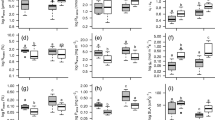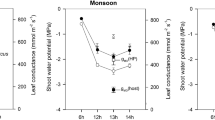Summary
In Australia, diurnal courses of leaf conductance and transpiration of hemiparasitic mistletoes (Loranthaceae) and their hosts were measured using steady-state porometers under conditions of partial drought and high evaporative demand. The sites spanned a diversity of climatic regions ranging from the subtropical arid zone with winter rainfall, through the subtropical arid zone with summer rainfall to the tropical summer rainfall zone. With one exception (Acacia farnesiana with deciduous leaves), the hosts were trees or shrubs with evergreen, sclerophyllous leaves or phyllodes.
The measurements confirm previous observations that mistletoes transpire at higher rates than their hosts. For adult leaves from all of the 18 different host/mistletoe pairs investigated, the daily average leaf conductances were higher in the parasites than in their hosts. The ratios ranged from 1.5 to 7.9. In the most extreme case,Amyema maidenii had a daily rate of water loss 8.9 times higher than its hostAcacia cowleana. Hoever, the parasites did not exhibit unlimited transpiration. Despite high water loss rates, leaf conductance showed large and consistent changes during the course of the day, indicating definite stomatal regulation. The typical diurnal pattern of conductance in both mistletoes and hosts consisted of an early morning peak followed by a continuous decrease throughout the remainder of the day. There was no abrupt decrease in leaf conductance of the parasites that might be interpreted as a threshold response with respect to internal water potential. In most cases, the continuous stomatal closure occurred without substantial changes in leaf water potential over a time span of several hours. The decrease in leaf conductance was correlated with an increase in leaf-to-air water vapor difference, which was associated with increasing leaf temperatures. It seems probable that external humidity plays a major role in the stomatal response. Diurnal courses of leaf conductance of the host/parasite pairs usually showed similar general patterns, even when the absolute rates were quite different. Thus, mistletoes not only control their water loss by stomatal action but this regulation seems to occur in coordination with the stomatal response of their hosts.
The integrated mistletoe/host system must also endure severe drought conditions. Controlled water use is necessary for long-term survival of the host. Assuming stomatal behavior in the host is well adapted to ensure its existence, then similar performance in the mistletoe would promote survival of both host and parasite.
Similar content being viewed by others
References
Beadle NCW (1982) The Vegetation of Australia. Fischer-Verlag, Stuttgart New York
Calder M, Bernhardt P (1983) The Biology of Mistletoes. Academic Press, New York
Chapman EA, Jacobs SWL (1979) Photosynthetic responses in semi-arid environments. In: Studies of the Australian Arid Zone. IV. Chenopod Shrublands (RD Graetz, KMW Howes, eds.), 41–53. CSIRO, Division of Land Resources Management, Camberra
Ehleringer JR, Cook CS, Tieszen LL (1985a) Comparative water use and nitrogen relationships in a mistletoe and its host. Oecologia (Berlin) (in review)
Ehleringer JR, Schulze E-D, Ziegler H, Lange OL, Farquhar GD, Cowan IR (1985b) Xylem mistletoes: Water or nutrient parasites? Science 227:1479–1481
Ehleringer JR, Schulze E-D (1985) Mineral nutrient concentrations in an epiparasiticPhoradendron californicum growing onP. californicum and its host,Cercidium floridum. Amer J Bot 72:568–571
Glatzel G (1983) Mineral nutrition and water relations of hemiparasitic mistletoes: a question of partitioning. Experiments withLoranthus europaeus onQuercus petraea andQuercus robur. Oecologia (Berlin) 58:193–201
Härtel O (1937) Über den wasserhaushalt vonViscum album L Ber Dtsch Botan Ges 55:310–321
Härtel O (1956) Der Wasserhaushalt der Parasiten. In: Handb der Pflanzenphysiologie III (O Stocker, ed.), 951–960. Springer, Berlin Göttingen Heidelberg
Hellmuth EO (1971a) Eco-physiological studies on plants in arid and semi-arid regions in Western Australia. III. Comparative studies on photosynthesis, respiration and water relations of ten aid zone plants under winter and later summer climatic conditions. J Ecol 59:225–259
Hellmuth EO (1971b) Eco-physiological studies on plants in arid and semi-arid regions in Western Australia. IV. Comparison of the field physiology of the host,Acacia grasbyi and its hemiparasite,Amyema nestor under optimal and stress conditions. J Ecol 59:351–363
Hollinger DY (1983) Photosynthesis and water relations of the mistletoe,Phoradendron villosum, and its host, the California valley oak,Quercus lobata. Oecologia (Berlin) 60:396–400
Kamerling Z (1910) Verdunstungsversuche mit tropische Loranthaceen. Ber Dtsch Bot Ges 32:17–24
Körner Ch, Cochrane PM (1985) Stomatal responses and water relations ofEucalyptus pauciflora in summer along an elevation gradient. Oecologia (Berlin) (in press)
Lamont BB (1983) Mineral nutrition of mistletoes, p. 185–204. In: The Biology of Mistletoes, Calder M, Bernhardt P (eds), Academic Press, New York
Pereira JS, Tenhunen JD, Lange OL, Beyschlag W, Meyer A (1985) Seasonal and diurnal patterns in leaf gas exchange ofEucalyptus globulus trees growing in Portugal. Can J Forestry (submitted)
Schulze E-D, Ehleringer JR (1984) The effect of nitrogen supply on growth and water-use efficiency of xylem-tapping mistletoes. Planta 162:268–275
Schulze E-D, Hall EA, Lange OL, Walz H (1982) A portable steady-state porometer for measuring the carbon dioxide and water vapor exchange of leaves under natural conditions. Oecologia (Berlin) 53:141–145
Schulze E-D, Turner NC, Glatzel G (1984) Carbon, water and nutrient relations of two mistletoes and their hosts: a hypothesis. Plant, Cell and Environment 7:293–299
Slavik B (1974) Methods of studying plant water relations. Ecological Studies 9, Springer, Berlin Heidelberg New York
Tenhunen JD, Lange OL, Harley P, Beyschlag W, Meyer A (1985) Limitation due to water stress on leaf net photosynthesis ofQuercus coccifera in the Portuguese evergreen scrub. Oecologia (Berlin) (in press)
Ullmann I (1985) Tagesgänge von Transpiration und stomatärer Leitfähigkeit Sahelischer und Saharischer Akazien in der Trockenzeit. Flora 176:383–409
Vareschi V, Pannier F (1953) Über den Wasserhaushalt tropischer Loranthaceen am natürlichen Standort. Phyton (Austria) 5:140–152
Walter H, Steiner M (1936) Die Ökologie der ostafrikanischen Mangrove. Z F Bot 30:65–193
Wolff EV (1980) Aschenanalysen von landwirtschaftlichen Produkten, II. Teil Weigant, Hempel, Parey, Berlin
Wood JG (1924) The relations between distribution, structure, and transpiration of arid south Australian plants. Trans Roy Soc S Austr 48:226–235
Author information
Authors and Affiliations
Rights and permissions
About this article
Cite this article
Ullmann, I., Lange, O.L., Ziegler, H. et al. Diurnal courses of leaf conductance and transpiration of mistletoes and their hosts in Central Australia. Oecologia 67, 577–587 (1985). https://doi.org/10.1007/BF00790030
Received:
Issue Date:
DOI: https://doi.org/10.1007/BF00790030




